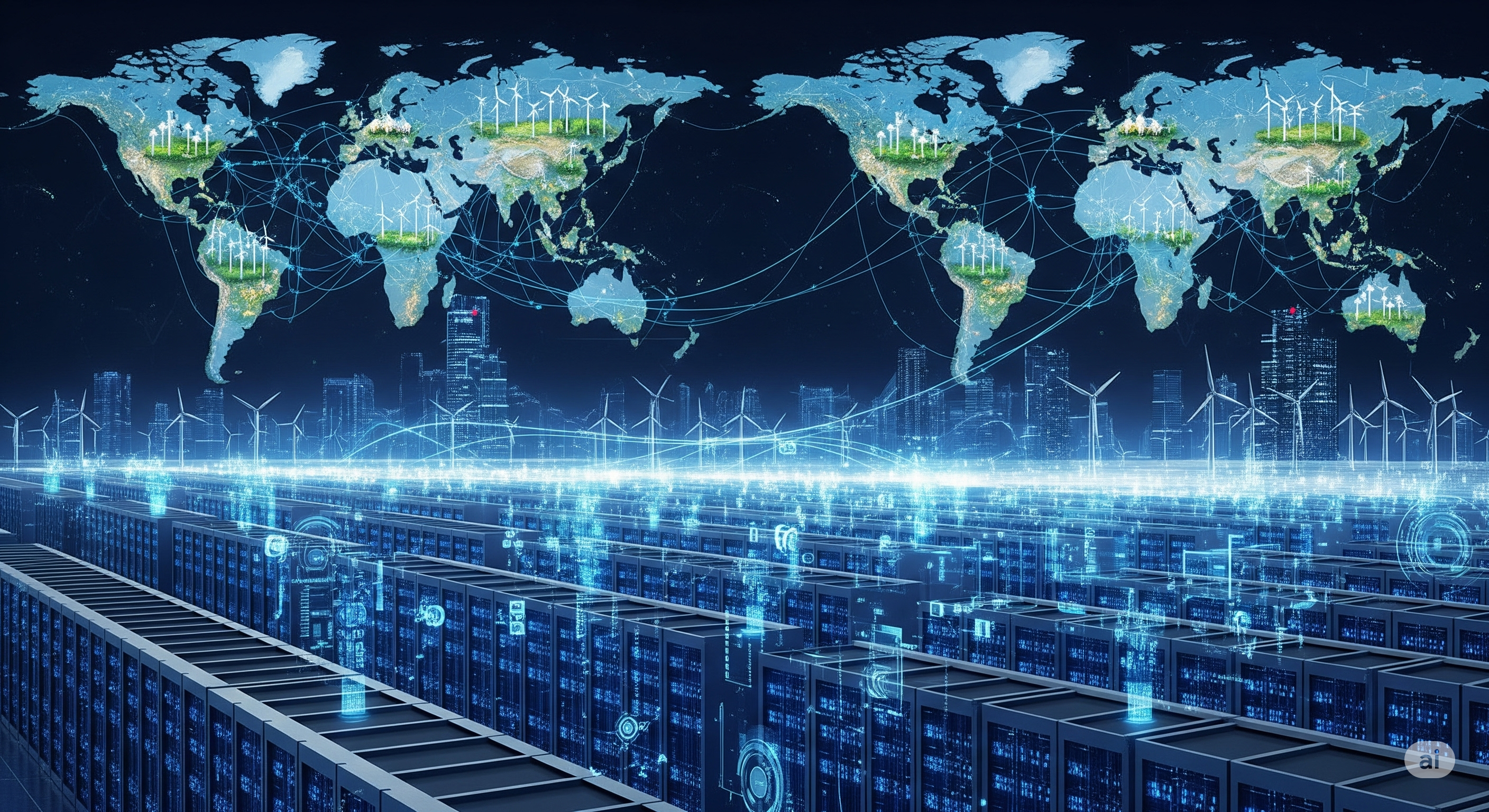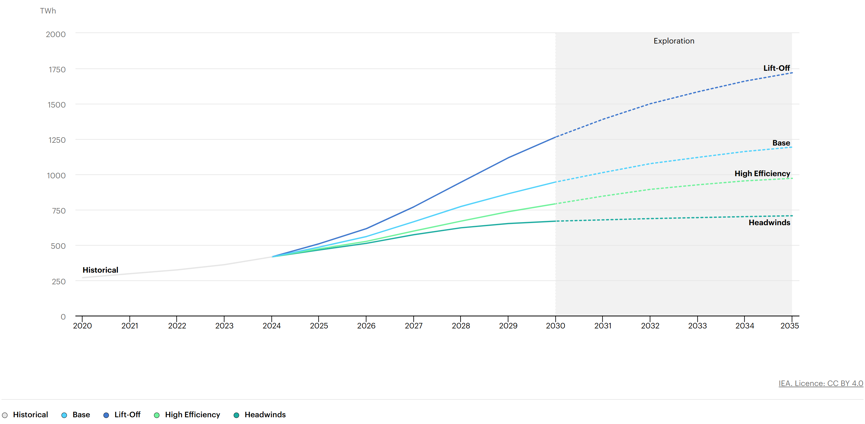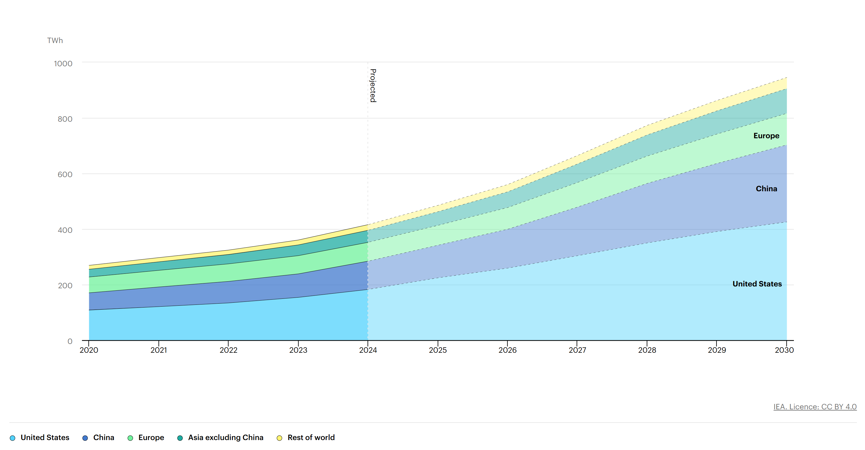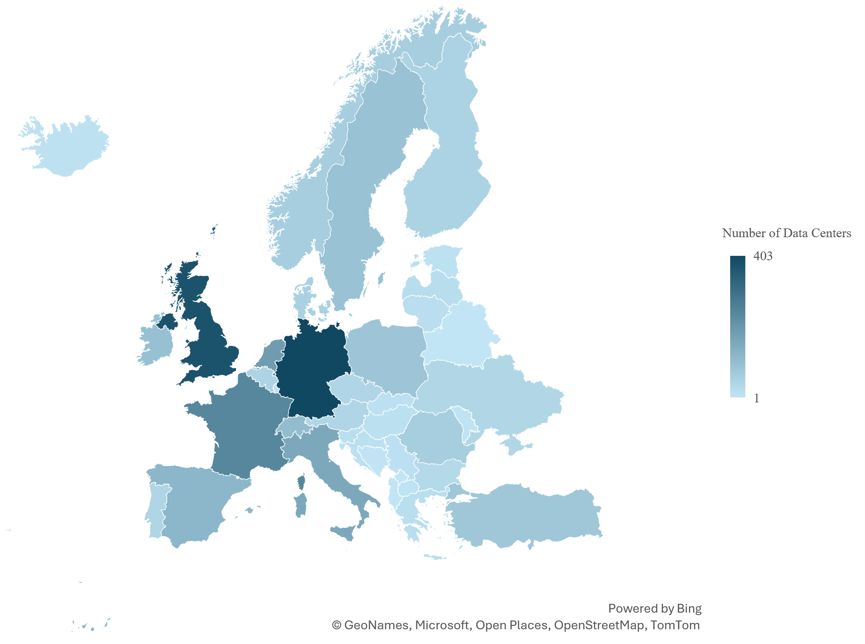
Newsroom / Center News
Digital Boom, Energy Gloom
The rise of advanced Artificial Intelligence is accelerating the digital revolution, reshaping industries, economies, and daily life. But behind the algorithms and automation lies an often-overlooked reality: AI's enormous appetite for energy. Training and running AI models—especially large language models and generative tools—require immense computational power, placing growing demands on data centers. These facilities are massive consumers of electricity, fundamentally tied to the global energy grid.
Data Centers: The Growing Demand for Electricity
In 2024, data centers globally consumed approximately 415 TWh of electricity, accounting for about 1.5% of total demand. The U.S. is the leader in data center energy consumption, accounting for 45% in 2024, followed by China and Europe at 25% and 15% respectively. According to projections by the International Energy Agency (IEA), data centers' electricity demand is expected to more than double by 2030, reaching approximately 945 TWh in the base scenario - a volume that is around Japan's current total electricity consumption. This represents an annual growth rate of around 15%, more than four times faster than the growth of total electricity consumption in all other sectors.


These infrastructures require a reliable, scalable, and cost-effective energy supply, making electricity the largest operating cost for AI data centers. As a result, hyperscalers are increasingly investing in Power Purchase Agreements (PPAs) for renewable energy, using them both as a hedge against market volatility and a tool to meet long-term sustainability goals.
Overview of the electricity use of data centers per country, [2024], European Commission
|
Country |
Total Electricity Consumption |
Share of National Electricity Consumption |
|
Belgium |
± 1,5 TW |
± 2 % |
|
Denmark |
1,3 TW |
± 4,7 % |
|
Finland |
± 0,7 TW |
± 1% |
|
France |
10 - 12 TW |
± 2,2 % |
|
Germany |
18 TW |
± 3% |
|
Ireland |
5,25 TW |
± 18 % |
|
Italy |
± 4,25 TW |
± 1,5 % |
|
Netherlands |
3,7 TW |
± 3,3 % |
|
Norway |
1,5 TW |
± 1,2 % |
|
Poland |
± 2 TW |
± 1 % |
|
Spain |
± 2,9 TW |
± 1,2 % |
|
Sweden |
3 TW |
± 2,3 % |
|
United Kingdom |
9-10 TW |
± 3 % |
Energy Supply Challenges and Solutions
Despite the efforts, significant challenges persist in the sector, as IEA’s estimations show that nearly 20% of planned data center projects could face delays due to grid connection bottlenecks, putting immense pressure on existing electricity grids. The intermittency of non-dispatchable RES is a great issue, the energy flow for data centers should be constant and reliable. To mitigate these risks, energy storage strategies should be implemented. Battery Energy Storage Systems (BESS) are well-suited for short-term storage, enabling the use of renewable energy when generation is low. For long-term storage, green hydrogen is a promising solution, although it is not yet cost-effective at scale.
Apart from the increasing energy demand, energy efficiency is another aspect to consider ensuring PUE (Power Usage Efficiency). Power Usage Effectiveness (PUE) is a key metric for assessing the energy efficiency of a data center. It is calculated by dividing the total energy consumed by the facility by the energy consumed solely by the IT equipment. A lower PUE indicates a more efficient data center, where a greater proportion of the power is used directly for computing rather than for cooling, lighting, or other auxiliary systems. Recent performance across several EU data centers shows that average PUE values have steadily improved, dropping from around 1.13 in 2017 to below 1.09 by 2024, reflecting efficiency gains through liquid cooling systems, thermal energy storage, smart power distribution, and hardware optimization.
Europe hosts over 2,000 data centers, with the highest concentration in Western Europe — notably Germany, the Netherlands, and the UK — benefiting from digital maturity, favorable regulations, and resilient electricity grids. However, a clear trend is the shift of data centers into Nordic countries, where low-cost renewable energy and colder climates offer a dual benefit for sustainability and operational savings. The sector’s electricity consumption in the EU has remained relatively stable in recent years, aided by higher efficiency standards.
Looking forward, the future of data centers is being shaped by an intersection of exploding digital demand and decarbonization goals. Modular designs, AI-optimized power use, waste heat recovery, and carbon-neutral commitments are reshaping construction standards. By 2030, global data center construction spending is projected to nearly reach $50 billion, driven by the urgent need for new, sustainable, and scalable digital infrastructure.
One of the paradoxes of the digital era is that while AI is a solution-provider for energy systems — enabling predictive maintenance, optimizing renewable generation, and improving grid operations — it is also a major source of increased energy consumption.

Greece: An Emerging Hub for Data and AI in Southeast Europe
Meanwhile, Greece is emerging as a strategic hub for data centers in Southeast Europe. Global tech giants are investing heavily in the country, leveraging its geographical location as a gateway for data traffic between Europe, the Middle East, and Africa. A recent grid analysis by IPTO shows that regions like Western Macedonia and Thessaly can support up to 700 MW and 650 MW of new data center capacity respectively—offering a clear map of viable investment locations beyond the already saturated Attica region. Following behind are Central Macedonia and Central Greece, and Epirus, and Western Greece with a cumulative capacity of 500MW and 400MW respectively. The investment plan for exploiting these available capacities is between €2-5 million and two capacity scenarios, 200MW as the base and 400-500MW as the optimistic outcome of new data centers until 2030.
A major milestone in this transformation is the recent announcement that Greece has been selected to host one of Europe’s first AI Factories, under the European AI Factories Initiative. The approved project, titled “Pharos – The Greek AI Factory for Accelerating AI Innovation”, is part of the EuroHPC Joint Undertaking and reflects the country’s rising role in the European digital ecosystem. The focus of the project will be on developing new AI services in three core domains: Health, Greek Language & Culture, and Sustainable Development. The project is co-financed with a €30 million budget launched on April 15th, 2025, with a duration of 36 months. Crucially, Pharos will harness the computational power of the “Daedalus” supercomputer, enabling Greece to contribute actively to Europe’s AI ecosystem while promoting homegrown innovation. Building on this momentum in June 2025, the consortium behind Pharos submitted a €43 million proposal for “Pharos 2”, a second AI Factory to be established in Western Macedonia, aiming to position Greece as a Southeast European powerhouse in compute infrastructure and innovation. This development will further enhance Greece’s role as a data and AI hub — integrating digital innovation with the sustainable energy systems required to support it.
Unlocking Green Energy for Europe’s Digital Future
This growing need for investments in green digital infrastructure is further supported by the recently adopted Clean Industrial State Aid Framework (CISAF) by the European Commission, in effect until 2030. CISAF is designed to provide increased flexibility for Member States to support renewable energy initiatives, industrial decarbonization, and the development of clean technology manufacturing capacity. This framework allows for faster approval processes and simplified procedures, encouraging a wave of green investments and making the EU a more attractive destination for clean energy capital. It signals a clear commitment from the EU to accelerate the green transition and enhance European competitiveness, providing a vital pathway for countries like Greece to integrate their digital ambitions with robust sustainability goals.
The Path Forward: Integrating Digital Growth with Sustainability
Achieving a balance between the booming data center growth and sustainability goals requires a multi-faceted approach:
- Urgent and substantial investments in new renewable energy sources, energy storage, and grid infrastructure to avoid bottlenecks and ensure reliable power
- Strategic siting of data centers in regions with grid capacity.
- Streamlining investment flows in both data centers and renewable energy sources through blended financial mechanisms such as CISAF.
- Continuous innovation in energy efficiency and smart operations to reduce the overall footprint.
AI is both a powerful enabler of innovation and efficiency, and a significant energy consumer. Navigating this paradox demands collaboration across research, industry, and policy — to power a sustainable digital future.



